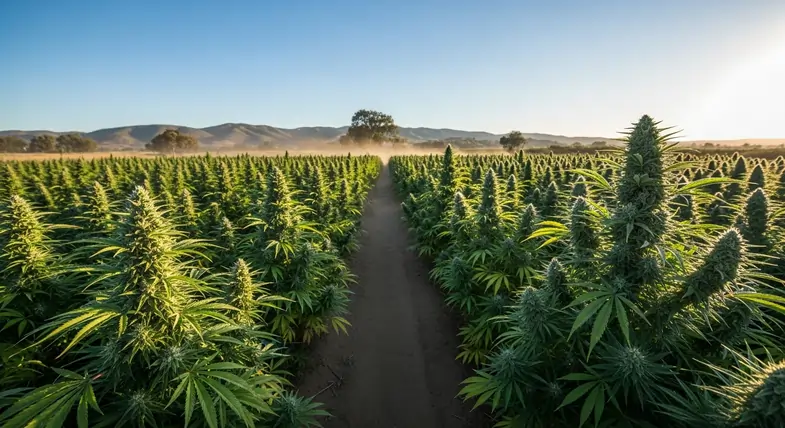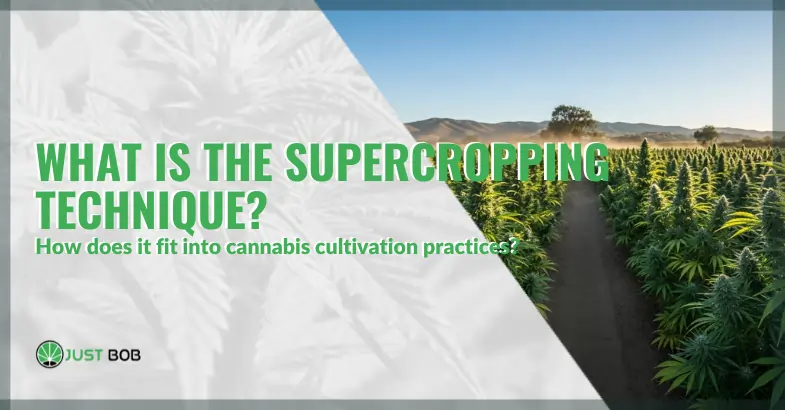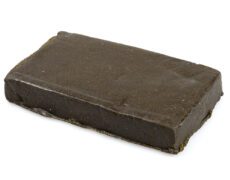Modified on: 26/10/2025
Through targeted compression of the branches, the formation of scar tissue is stimulated, which enhances the plant’s robustness
In the world of advanced botany, there are boundaries where science meets an almost artistic practice, a physical dialogue between the grower and the plant. Horticultural specialists have long understood that plant growth is not an immutable destiny, but a path that can be guided, influenced and optimised.
Through a series of techniques known as “training”, it is possible to shape the structure of a plant to maximise its health, vigour and potential. Among the most discussed and technically demanding methods is supercropping, a practice that conjures up images of drastic intervention but which, in reality, is based on a deep understanding of plant physiology.
However, before delving into the technical analysis of this method, it is essential to establish the scope of this discussion from the outset. This article by Justbob is for informational and educational purposes only, designed to satisfy intellectual curiosity about complex agricultural practices.
It is not intended in any way to promote, encourage or provide instructions for the cultivation of cannabis, a practice which, it should be clearly remembered, is subject to strict regulations in the United Kingdom.
Readers are therefore urged to inform themselves thoroughly and to comply strictly with the laws in force in their own territory.
Having clarified this essential prerequisite, we can now explore, from a purely theoretical and botanical perspective, what supercropping really is.
Read also: How marijuana is grown in winter: challenges, techniques and environmental factors
What is supercropping? A detailed analysis
Supercropping, sometimes described in technical contexts as “stem mutilation”, is a high-stress training (HST) technique.
Its fundamental objective is to induce a defensive reaction in the plant. If the technique is performed correctly, this reaction can lead to more robust growth and a denser structure. The procedure consists of carefully bending the branches until the internal fibrous tissue (the xylem and phloem) is damaged without breaking the outer bark.
After undergoing this controlled trauma, the plant activates its repair mechanisms. At the point of bending, a thickened “knuckle” forms, a scar tissue that not only repairs the damage but also structurally reinforces the branch at that point.
This process is based on a complex hormonal response. Acute stress causes the plant to redistribute auxins, growth hormones that normally promote apical dominance (the tendency to grow mainly upwards). By interrupting this flow, more lateral and bushy development is encouraged.


Difference between supercropping and Low-Stress Training (LST)
To fully understand supercropping, it is useful to compare it with its conceptual opposite: Low-Stress Training, also known as LST. Both techniques aim to shape plant growth to improve light exposure and, consequently, increase productivity. But they do so with profoundly different approaches.
Low-Stress Training is a gentle and gradual practice. As the name suggests, it is a low-impact method that does not cause trauma to the plant. The branches are slowly bent and fixed in position over time, guiding the plant structure with patience and delicacy. It is a technique that is accessible even to less experienced growers, similar to a form of guided horticulture, where control is exercised without forcing.
Supercropping, on the other hand, is based on the opposite idea. It is one of the so-called high-stress techniques, because it is based on inducing a small controlled trauma. The grower acts decisively, slightly crushing the branches to damage the internal tissue without breaking the bark.
This stimulates a “defensive” response in the plant, leading to more robust growth and better lateral development. It is a more advanced technique, requiring a good knowledge of plant physiology and a certain amount of manual skill to avoid causing irreversible damage.
In summary, LST could be considered a form of basic training and supercropping its advanced counterpart, intended for experienced growers who always operate in full compliance with the law.
The theoretical benefits associated with supercropping
In specialist growing circles, supercropping is believed to have several theoretical benefits. It is important to analyse them with a critical and scientific eye, bearing in mind that results can vary greatly depending on countless factors.
- Denser and more compact plants: by breaking apical dominance, the plant is stimulated to develop a denser, more horizontal canopy. This results in a lower, bushier structure, which can be advantageous in growing spaces with limited height. The “core” that forms at the bend makes the branch stronger and able to support more weight.
- Optimisation of potential yield: a more uniform and flat canopy allows for more even light distribution. In theory, when more flowering sites receive direct and adequate lighting, the overall yield potential of the plant increases. Supercropping aims to create this ideal canopy, maximising the photosynthetic efficiency of the entire plant.
- Potential increase in secondary compounds: stress is one of the main catalysts for the production of secondary metabolites in plants, such as cannabinoids and terpenes. These compounds are part of the plant’s natural defence mechanism against pests, predators and environmental stress. It is theorised that acute stress induced by supercropping may stimulate the plant to produce a higher concentration of these molecules. Please note: any end product must strictly comply with the THC limits imposed by UK law. This is purely a biochemical discussion and is not an encouragement to produce non-compliant material.
- Better light penetration: related to point two, a less congested canopy in the centre and more expansive at the sides allows light to penetrate deeper, reaching even the lower parts of the plant that would otherwise remain in shadow.
- Greater plant resilience: the principle is similar to that of physical exercise: controlled stress strengthens. By overcoming trauma, the plant not only repairs itself but becomes structurally stronger and potentially more resistant to future mechanical stress, such as wind or the weight of flowers.
The ideal timing: when should supercropping be applied
Timing is crucial to the success of supercropping. Unlike other training techniques that are applied in the early stages of growth, this one requires patience and careful observation of the plant’s development.
The ideal time to intervene is during the advanced vegetative phase, usually after the third or fourth week of growth, when the plant has reached a height of at least 30 centimetres. At this stage, the stems are still elastic but already strong enough to withstand the intervention, and the plant has sufficient energy to react positively to stress.
On the contrary, supercropping should never be performed during flowering. At this time, the plant concentrates all its resources on flower production: hormones change, the structure stiffens and the stems become more fragile. Intervening at this stage carries a high risk of breakage, with damage that can irreparably compromise the quality and quantity of the harvest.
Another aspect to consider carefully is genetics. Each cannabis strain follows its own growth rhythm: some grow quickly and vigorously, others more slowly. Growers must be familiar with the characteristics of the specific genetics in order to choose the right time to intervene, always in compliance with current regulations.
Finally, it is essential that the plant is in perfect health. Supercropping is an invasive technique and cannot be applied to specimens weakened by environmental stress, nutritional deficiencies or parasitic infestations. A plant that is already compromised and subjected to this type of stress is likely to fail to recover, leading to death in the most serious cases.
The supercropping method: procedure and precautions
Let us now describe the supercropping procedure in more detail:
- Identification of branches: examine the plant and visualise an imaginary line that will represent the future height of the canopy. Select the tallest and most vigorous branches that exceed this line. Generally, start with the side branches before proceeding, with much more caution, to the main stem.
- Pressure and bending: grasp the selected branch between your thumb and forefinger. Apply firm but gradual pressure while simultaneously “massaging” or rolling the branch slightly to soften the internal fibres. After 5-10 seconds, you should feel that the internal tissue has given way, becoming soft and flexible. At this point, slowly bend the branch 90 degrees in the desired direction.
- Support and recovery: if a branch, especially a thicker one, seems unstable after bending, it may be helpful to provide temporary support. A small piece of grafting tape or simple insulating tape can act as a “brace” for the first week, protecting the bend and keeping it in place. Afterwards, you may need to gently tie the bent branch to prevent it from straightening and growing back upwards as it recovers.


Limitations and disadvantages of supercropping
The risk of error is inherent in this technique. Accidental breakage of a branch is common, especially for beginners. If the outer bark breaks, it is essential to act quickly. You can attempt immediate “field dressing” by realigning the parts and bandaging the wound with adhesive tape. Cannabis plants are notoriously resilient, and often a wound of this type can heal in 10-14 days. However, this highlights the delicate and risky nature of the operation.
Although supercropping promises interesting advantages in terms of yield and growth control, it is not a technique suitable for all situations. It has some limitations that should be taken into account before applying it.
The first concerns autoflowering varieties. Unlike photoperiod plants, these plants have a very rapid and predetermined life cycle: they enter flowering after a few weeks, regardless of the photoperiod. This makes them particularly vulnerable to any stress, such as that caused by supercropping. As they do not have enough time to recover, they risk stalling or suffering permanent damage, which is why the technique is not recommended in these cases.
Another critical aspect is related to the effort required. When working with a few plants, supercropping is a manageable practice and can even become part of a personalised care routine. But if you move on to larger crops (obviously within the limits set by current legislation), the situation changes.
Bending and manipulating each individual branch precisely, controlling the recovery time and development of each plant, requires many hours of work.
Read also: Synthetic hashish: what makes this artificial compound a growing concern in the cannabis world
A technique for experts, to be approached with caution
Supercropping is one of the most advanced techniques in plant training. It is a technique that balances risk and potential reward, requiring knowledge, patience and a delicate touch. Its principle is based on stimulating the plant’s intrinsic resilience through calculated trauma, with the theoretical aim of achieving a stronger structure, a more efficient canopy and a better expression of its genetic potential.
However, it is essential to conclude with one final, categorical warning. This article has explored supercropping in a purely educational and intellectual context. Cannabis cultivation is strictly regulated in the United Kingdom and many other jurisdictions.
Acting in full compliance with local laws is a civic and legal duty. Knowledge is a powerful tool, but it must always be exercised responsibly and in full compliance with the current regulatory framework.
See you soon on Just Bob with more articles exploring the diverse world of hemp and CBD. See you in the next article!
Supercropping on cannabis crops: takeaways
- Supercropping is a high-stress training (HST) technique that involves deliberately damaging the internal fibres of a branch to manipulate the plant’s growth. The theoretical aim is to promote a denser structure and improve light exposure, but the information is provided for educational purposes only.
- It is a high-risk practice, suitable only for healthy photoperiodic plants in an advanced vegetative stage. It requires skill, patience and an adequate recovery period for the plant. Human error can cause significant damage.
- The information is presented for intellectual curiosity only. Cannabis cultivation is subject to strict laws in the United Kingdom. It is mandatory to always act in full compliance with local regulations and consult specialists before considering any related activities.
Supercropping on cannabis crops: FAQ
Supercropping is a high-stress training (HST) method that involves deliberately damaging the internal fibers of a plant stem—without breaking the outer skin—to encourage stronger, bushier growth. Unlike low-stress training (LST), which gently guides plant structure over time, supercropping relies on a controlled stress response to stimulate lateral development and improve light exposure. It requires more experience and precision.
Can supercropping be used on autoflowering cannabis plants?
No, in countries where this practice is legal, supercropping is not recommended for autoflowering strains. These plants have a very short, predetermined life cycle, quickly moving from the vegetative to the flowering stage. They do not have the time or energy to recover from the stress caused by supercropping, which could lead to stunted growth or permanent damage
How does supercropping differ from Low-Stress Training (LST)?









